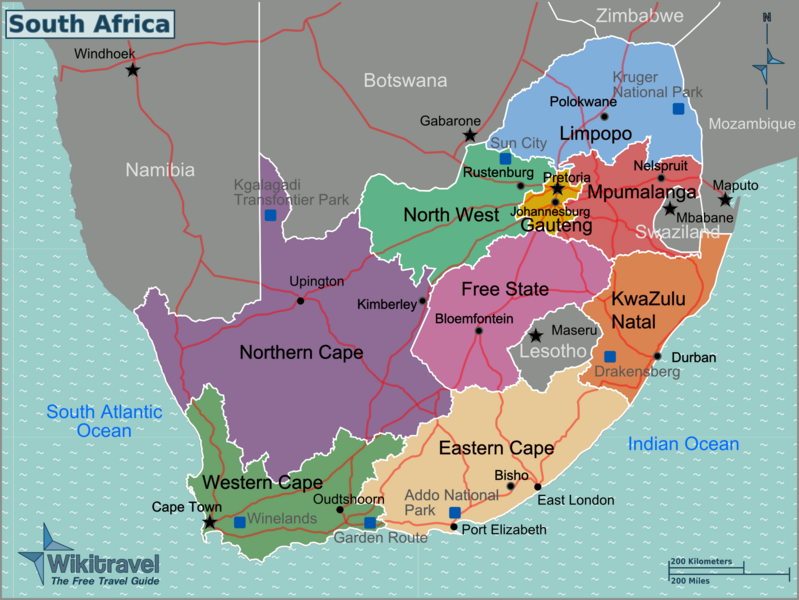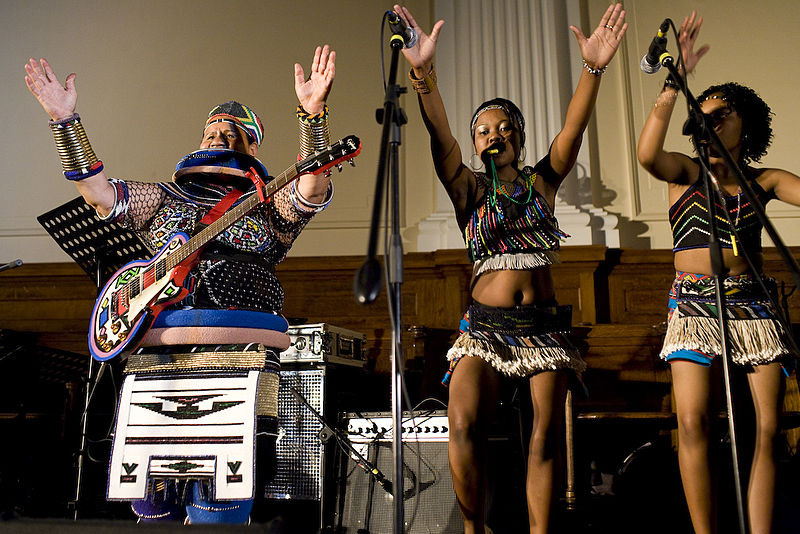South Africa
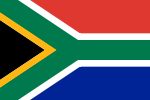
South Africa is one of the richest and most economically developed countries in Africa. It is in South Africa that the most African movies and books are published, the Cape Town Book fair presents the “best of” in literature and lyrics every year.
Location and Landscape
Because of its excellent location between the Atlantic and the Indian Ocean, South Africa has attracted people from all over the world for centuries. Asians and Indians came to South Africa long before the first European ships landed on the Cape of Good Hope.
The new arrivals had to share this magical land with the San, the hunters of the bushland, and the descendants of the Bantu people.
The landscape of South Africa is very diverse. The country consists of deserts and savannas, high mountains, orchards and vineyards. There are tropical rainforests in the valleys of the Limpopo River. The Kalahari Desert extends from South Africa to Botswana and Namibia.
The Great Karoo, a bleak steppe landscape, stretches to the north of the Swartberg (Black Mountains in Afrikaans). In the Karoo, we find the Camdeboo National Park and the spectacular Valley of Desolation, which draws visiters from across the world. These formations are said to have been caused by hundreds of thousands of years of volcanic activity and erosive forces. During the day it is dry and hot but in the night temperatures can fall to freezing.
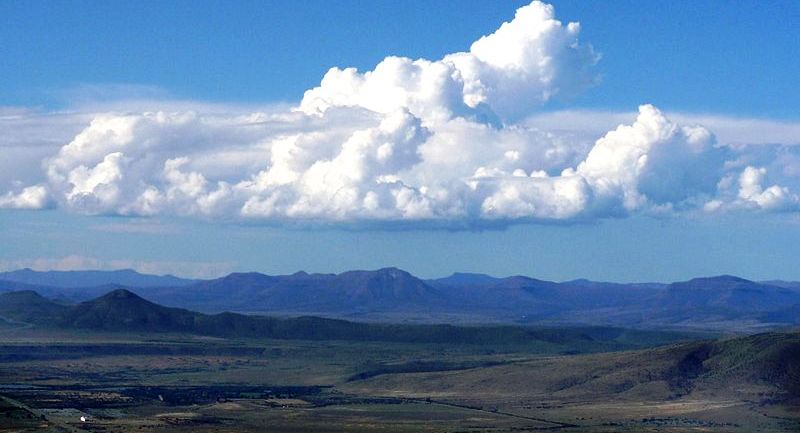
(c) Michael Clarke Stuff
On the border of the provinces of Mpumalanga and Limpopo we find beautiful natural wonders like ‘God’s Window’ and the Blyde River Canyon, one of the largest in the world. The canyon forms part of the Blyde River Canyon Nature Reserve, an area of over 25 000 ha that offers a range of activities from hiking to scenic drives. The popular Kruger National Park is within easy reach by car.
The spectacular Drakensberg mountain range falls within the province of KwaZulu-Natal and forms part of the uKhahlamba-Drakensberg Park, a UNESCO World Heritage Site, for its scenic beauty, rock art and diverse flora and fauna. Most rivers originate in the Drakensberg (Dragon Mountains), such as the Oranje, which is the biggest river in South Africa. It flows through a great deal of the country in a westerly direction and joins the Atlantic Ocean. All other rivers flow eastwards into the Indian Ocean.
The Northern Cape is the largest province in South Africa and also falls within the arid Kalahari region, which extends into Botswana and parts of Namibia. Here, rainfall is low and the summer temperatures are extremely high.
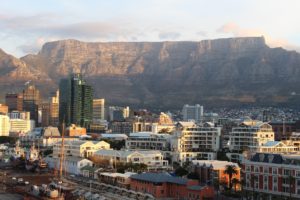
(c) pixabay
The southern-most province in South Africa is the Western Cape, home to majestic Table Mountain and natural wonders like Cape Point. Towards Cape Agulhas, the southernmost tip of Africa, you’ll find Grootvadersbosch, an area known for its beautiful nature trails, fantastic bird-watching opportunities and indigenous forest.
The kingdom of the Sotho speaking people, Lesotho, lies in the middle of South Africa. It is situated in the Drakensberge and is called “the kingdom in the sky”.
Tshwane, the Capital of South Africa
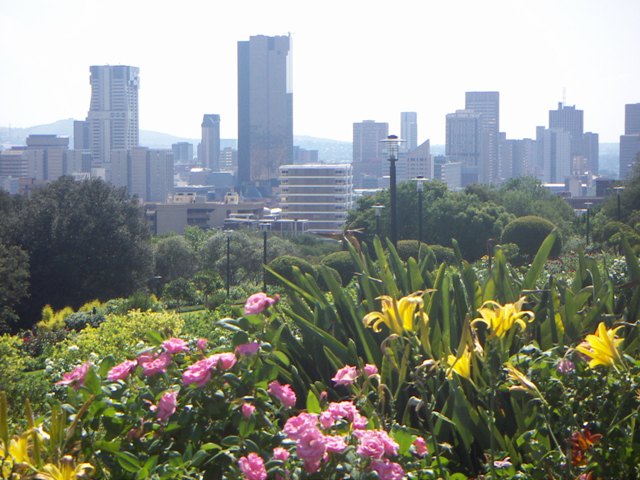 The capital of South Africa is Tshwane. The former capital, Pretoria, is also known as the City of the Jacaranda Flowers and is famous because of its beautiful Jacaranda trees. Tshwane lies in the valley of the Apies River and has very fertile soils. In earlier times, the cattle of the Zulus grazed here, the Boers settled here when they arrived with the Great Trek in the 19th Century.
The capital of South Africa is Tshwane. The former capital, Pretoria, is also known as the City of the Jacaranda Flowers and is famous because of its beautiful Jacaranda trees. Tshwane lies in the valley of the Apies River and has very fertile soils. In earlier times, the cattle of the Zulus grazed here, the Boers settled here when they arrived with the Great Trek in the 19th Century.
The lively coastal town of Cape Town and hectic Johannesburg are the secret capital cities of South Africa. Cape Town is famous because of the Table Mountains. Johannesburg was temporarily the centre of the Anti-Apartheid movement. The big townships in Johannesburg are a result of the racial policies instigated by the former white government. In the township of Soweto, there is a memorial to commemorate the Student Riots of 1976.
South Africa, the Rainbow Nation

(c) Ninconquer
South Africa is called the Rainbow Nation due to the many different people living there and the many languages spoken. There are 11 official languages and most South Africans are at least bilingual. The majority of the South African population belongs to the Zulu, Xhosa and Ndebele peoples. These are descendants of the Bantu people who migrated to South Africa from the Congo centuries ago. The descendants of white immigrants from England, Portugal, Israel and the Netherlands make up around 10 per cent of the population. Descendants of the Dutch are known as Boers. Like the black population, they consider themselves the true South Africans. Asian people make up the smallest population. English settlers brought them from the Indian and Indonesian colonies to South Africa to work on the farms. They were treated as slaves. The oldest South Africans are the San Bushmen. They were almost completely forced out of South Africa by black peoples and white settlers. Learn more about the people of South Africa.
Plants and Animals
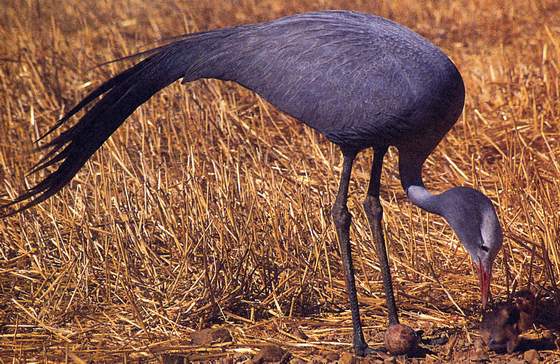
Economy and Natural Resources
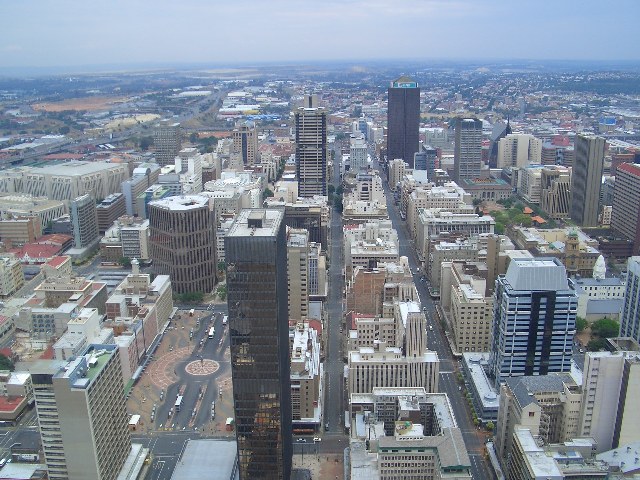
(c) Zakysant
South Africa is the second largest economy in Africa after Nigeria. The country is rich in mineral resources. South Africa was revolutionised in the 1800s by the discovery of gold. The country’s rich natural resources laid the foundation for its economy and mining is still an important source of revenue today. Gold mines have attracted adventurers from all over the world. Over 10% of South Africa is involved in the production of gold. The majority of energy in this industry-rich land is generated by coal power stations. South Africa is the first African country that attempted to make the switch to nuclear power. There is a nuclear power plant near Cape Town. Apart from gold, the country has a wealth of other mineral reserves such as iron ore, platinum, manganese, chromium, copper, uranium, silver and titanium. Agriculture and fishing are of major importance, contributing to the domestic economy and providing a significant portion of South Africa’s exports. Food processing, canning and sugar refining are also key manufacturing activities. Tourism is a key sector of South Africa’s economy with excellent potential for growth. South Africa’s spectacular scenery, and excellent infrastructure make it one of the most desired destinations in the world. The sector was given a massive boost by the successful hosting of the World Cup in 2010, when the country received more than 8.1-million foreign visitors. Today tourism supports one in every 12 jobs in South Africa. The financial sector is one of the largest among emerging markets and includes sophisticated banking and bond markets. Despite the rich natural resources and booming industries many South Africans are poor, and the mining industry has been hurt by falling commodity prices and bitter labor strikes that have driven up production costs. Rates of formal-sector unemployment and crime are high, and the quality of public education is not so good. Access to infrastructure and basic services is lacking.
Holidays and Festivals
There are many celebrations alongside the Christian holidays Christmas, Easter and New Year.
Most of them take place on the anniversaries of historical events: “Human Rights Day” on 21st March; “Freedom Day” on 27th April and “Youth Day” in June. The 24th September is regarded as “Heritage Day” and “Day of Reconciliation” after apartheid is celebrated on the 16th December. “Women’s Day” is on the 9th August. The Zulu also celebrate the “Shaka Day”.
South Africa’s History
The first inhabitants of South Africa were the San, also known as “Bushmen” and the Khoikoi. They have lived in South Africa for more than 170,000 years. Their impressive rock paintings are the first evidence of civilisation. During the first millennium Bantu peoples from the Congo migrated to South Africa and began to force out the Bushmen and settle on the highlands. Then the Europeans arrived.
Portuguese sailors attempted to find routes to the spice islands of Asia. For many years the Portuguese had been pushing further and further south along Africa’s western coastline and in 1487 Bartholomew Diaz made it around the Cape of Good Hope. Ten years later Vasco da Gama rounded the Cape and continued up the continent’s eastern coast before heading further east, eventually to India. Over the next 200 years an increasing numbers of Portuguese traders and their Dutch and British competitors made the journey to the east via the Cape of Good Hope. The Dutch were the first European trading power to set up a permanent settlement in South Africa. In 1652 the powerful Dutch East India Company established a supply station under the command of Jan Van Riebeeck on a site that later became Cape Town. The company did not envisage the settlement growing into a larger community, but only some decades later the first Dutch settlers entered South Africa. Since then South Africa has become a location for conquests, wars and racial battles.
More on History South Africa
South Africa Today
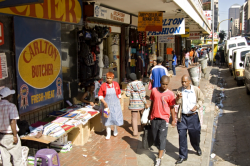 Apartheid ended more than two decades ago. South Africans are continually working on reconciliation between black and white, between tradition and democracy. They are making many attempts to find a suitable and just way of living together. The system of government in South Africa is a presidential republic, which means the people elect the President. There are many political parties. The strongest party is the ANC, African National Congress, which fought against apartheid. Today the party’s most important task is to distribute the wealth of the country fairly. South Africa is one of the world’s most important gold sources and is therefore very rich. Too little of the profit made from the gold industry is given to the state and too little is being done to benefit education and employment. Unemployment is high among young South Africans. The many political youth initiatives and the critical press who both aim to confront South Africa’s problems display hope for improvement. The population shows it is prepared to support further changes and that it is not happy to allow politicians to have full responsibility for governing the country. On the occasion of the 2012 World Cup, South Africa showed the world that is on the right track towards achieving a more open society.
Apartheid ended more than two decades ago. South Africans are continually working on reconciliation between black and white, between tradition and democracy. They are making many attempts to find a suitable and just way of living together. The system of government in South Africa is a presidential republic, which means the people elect the President. There are many political parties. The strongest party is the ANC, African National Congress, which fought against apartheid. Today the party’s most important task is to distribute the wealth of the country fairly. South Africa is one of the world’s most important gold sources and is therefore very rich. Too little of the profit made from the gold industry is given to the state and too little is being done to benefit education and employment. Unemployment is high among young South Africans. The many political youth initiatives and the critical press who both aim to confront South Africa’s problems display hope for improvement. The population shows it is prepared to support further changes and that it is not happy to allow politicians to have full responsibility for governing the country. On the occasion of the 2012 World Cup, South Africa showed the world that is on the right track towards achieving a more open society.
Attractions
The Cradle of Humankind, at Maropeng, is near by Johannesburg. This 47 000ha area is famous for its rich fossil record showing early human evolution, and is at the centre of UNESCO’s World Heritage Fossil Hominid Site.
The famous Garden Route, known as South Africa’s Eden, traverses an area rich in natural beauty and charm, attracting adventure-seekers and outdoor enthusiasts.
Tip: January sees hot and dry weather in the Cape, making it an excellent time of year for trips to Cape Town and the Garden Route.
Kruger National Park, the world-renowned park of nearly 2 million hectares features 16 ecosystems. Spot the Big Five on a game drive or walking safari.
Tip: The best time to visit Kruger and most wildlife parks is from May to September. This is the Dry season and animals congregate around waterholes and rivers.
Robben Island’s most famous prisoner, Nelson Mandela, has turned this institute of brutality into a symbol of the triumph of the human spirit over enormous hardship.
In Johannesburg, the ‘City of Gold’, you can feel South Africa’s pulsating heartbeat with its endless opportunities for entertainment and freedom tours.
Soweto, South Africa’s largest and most famous township was a hotbed of anti-apartheid activity. Visit Freedom Struggle sites and eat at a shebeen or township restaurant.
Cape Town and the Cape Peninsula up to Cape Point, are famous for scenic beauty; celebrity beaches; Table Mountain; whale-watching.
South African Literature
The long history and large variety of people in South Africa gave way to the most diverse literature on the continent. It strongly reflects the history of the country.
The first storytellers were the San, whose stories have been passed down for thousands of years. Their tales are exotic and strange. They tell of the difficult living conditions in the deserts, and also of age old myths about the creation of the world.
They tell of a time when people and animals lived together. The old myths and fairy tales helped the people to get over the dark years of racism and oppression. They put their trust in the fact that there is a higher presence at work, and that a society can only survive if certain rules are adhered to. They also keep faith in the fact that in the end the power of good will be victorious.
Nelson Mandela’s favourite tales, Gcina Mholope’s stories and Nick Greaves’ animal fables transport us to the campfire, just like the people who heard them thousands of years ago.
The first South African novels were set between the 16th and 19th Centuries, when the area was settled by Europeans. They tell about colonisation, banishment and wars. Thomas Mofolo’s biography about a Zulu Warrior, Chaka, tells a different story. He tells the true story of an African hero who, through his extraordinary warfare and brutality, built a great kingdom from a little tribe.
During apartheid in the 20th Century, censorship was very strict and many writers left South Africa. However the time right before the end of apartheid and just afterwards, was the most productive literary era. South African literature achieved international acclaim thanks to the authors J.M. Coetzee and Nadine Gordimer, who were both awarded the Nobel Prize for literature. In their works, they critically exposed the time of apartheid. Alan Paton wrote the first “Anti-Apartheid” novel Cry the Beloved Country. The book was a bestseller and was even filmed twice. Zakes Mda, a famous black novelist, won the Commonwealth Writers Prize with his novel The Heart of Redness. His book is read as part of the school curriculum in South African schools.
The young South Africans love short stories. They allow the authors to respond quickly to social phenomena or political events.
The collection of stories Yizo Yizo is a great example of this. South African authors describe the everyday life in South Africa after the end of apartheid. They discuss the still existing conflicts between black and white and men and women. They discuss the obvious compromise of their fathers and attack the forced reconciliation of the last decade.
Crime is the most popular fiction genre in South Africa. Deon Meyer became internationally known with his fast-paced crime novels.
A phenomenon in South African literature is the popularity of comics.
Madam & Eve, the cartoon from the American Stephen Francis and two South Africans Harry Dugmore and Rico Schacherl caused a real hype in South Africa. The comic describes the totally normal frenzy of an African family, in which the white Madam and her black maid Eve run a bizarre regiment.
Read more on the website www.madameve.co.za

